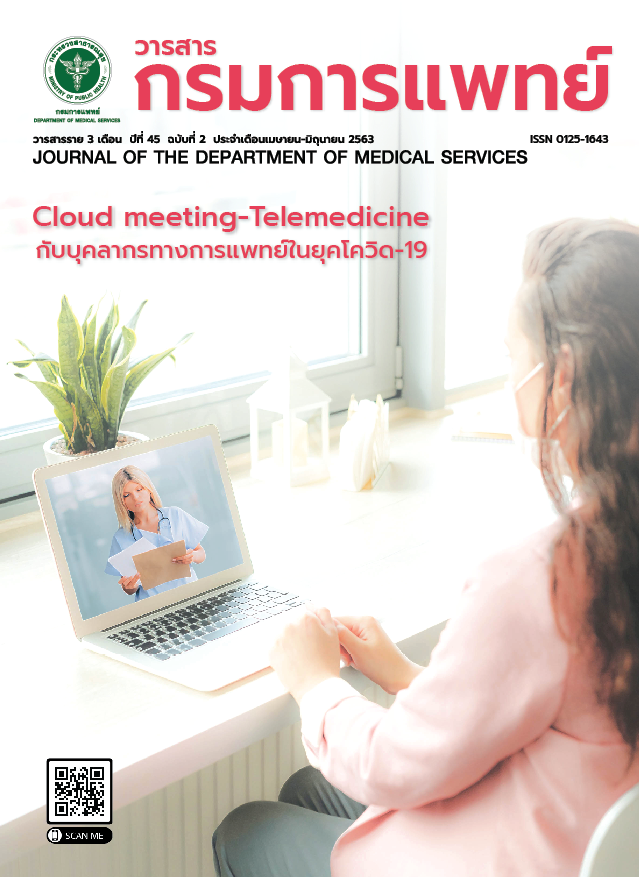ความชุกและสาเหตุของการนอนโรงพยาบาลด้วยอาการชักใน โรงพยาบาลสระบุรี
คำสำคัญ:
โรคลมชัก, การนอนโรงพยาบาล, ความชุกบทคัดย่อ
ภูมิหลัง: โรคลมชักเป็นโรคเรื้อรังที่ควรควบคุมได้ด้วยการดูแลรักษาแบบผู้ป่วยนอก การนอนโรงพยาบาลนี้สามารถป้องกันหรือลดลงได้หากผู้ป่วยได้รับการรักษาในระดับปฐมภูมิอย่างถูกต้องในระบบบริการสุขภาพที่มีคุณภาพดี รายงานของสำนักงานวิจัยเพื่อการพัฒนาหลักประกันสุขภาพไทย ปี พ.ศ. 2551-2553 พบว่าโรคลมชักมีอัตราการนอนโรงพยาบาลเพิ่มขึ้น อย่างไรก็ตามยังไม่มีรายงานความชุกของการนอนโรงพยาบาลด้วยอาการชักในโรงพยาบาลสระบุรี
วัตถุประสงค์: การศึกษานี้มีวัตถุประสงค์เพื่อหาความชุกและสาเหตุของการนอนโรงพยาบาลด้วยอาการชักในโรงพยาบาลสระบุรี
วิธีการ: เก็บข้อมูลปฐมภูมิจากการทบทวนเวชระเบียนย้อนหลังของผู้ป่วยลมชักกลุ่มผู้ใหญ่อายุตั้งแต่ 15 ปีขึ้นไปที่นอนโรงพยาบาลด้วยอาการชักที่โรงพยาบาลสระบุรีในช่วงระหว่างวันที่ 1 มกราคมถึง 31 ธันวาคม 2560 และมีผู้ป่วยจำนวน 402 รายได้รับการรักษาด้วยยากันชักที่แผนกผู้ป่วยนอกโรงพยาบาลสระบุรีอย่างน้อย 2 ครั้งในช่วงเวลาที่ศึกษา
ผล: ผู้ป่วย 67 ราย (ร้อยละ 16.7) มีการนอนโรงพยาบาลด้วยอาการชักโดยมีสาเหตุมาจากความไม่ร่วมมือในการใช้ยามากที่สุด (ร้อยละ 50.8) ผู้ป่วยมีการนอนโรงพยาบาลเฉลี่ย 1.8 ครั้งต่อปี (ส่วนเบี่ยงเบนมาตรฐาน 1.3) และค่ามัธยฐานของจำนวนวันนอนเท่ากับ 2.0 วันต่อครั้ง (พิสัยควอไทล์ 2.0-3.0) ทำให้เกิดต้นทุนทางตรงทางการแพทย์ครั้งละ 5,215 บาท (ส่วนเบี่ยงเบนมาตรฐาน 2,826) หลังจากมีการนอนโรงพยาบาลแล้วผู้ป่วยเกือบทั้งหมด (ร้อยละ 95.5) มีอาการดีขึ้นสามารถกลับบ้านได้และส่วนใหญ่ (ร้อยละ 65.2) ได้รับยากันชักชนิดเดิม อย่างไรก็ตามปัจจุบันยังไม่มีคลินิกโรคลมชักในโรงพยาบาลสระบุรี ซึ่งอาจช่วยลดปัญหาต่างๆ ในผู้ป่วยกลุ่มที่ต้องการได้รับคำปรึกษาแนะนำเพิ่มเติม นำไปสู่การเพิ่มอัตราการหายชัก ลดการนอนโรงพยาบาลด้วยอาการชักและลดการใช้ ทรัพยากรทางสุขภาพลงได้
สรุป: ความชุกของการนอนโรงพยาบาลด้วยอาการชักที่โรงพยาบาลสระบุรีเท่ากับร้อยละ 16.7 โดยมีสาเหตุมาจากความไม่ร่วมมือในการใช้ยามากที่สุด
เอกสารอ้างอิง
Asawavichienjinda T, Sitthi-Amorn C, Tanyanont W.Prevalence of epilepsy in rural Thailand: a population-based study. J Med Assoc Thai 2002; 85: 1066-73.
Limwattananon S. Manual Analysis of Age-Standardized Hospitalization with Ambulatory Care Sensitive Conditions, Acute Myocardial Infarction, Ischemic and Hemorrhagic Strokes. 1st ed. Nonthaburi. Health Insurance System Research Office; 2011.
Sajatovic M, Welter E, Tatsuoka C, Perzynski AT, Einstadter D. Electronic medical record analysis of emergency room visits and hospitalizations in individuals with epilepsy and mental illness comorbidity. Epilepsy Behav 2015; 50:55-60.
Mitchell RJ, Herkes G, Nikpour A, Bleasel A, Shih P, Vagholkar S, et al. Examining health service utilization, hospital treatment cost, and mortality of individuals with epilepsy and status epilepticus in New South Wales, Australia 2012-2016. Epilepsy Behav 2018; 79: 9-16.
Strzelczyk A, Griebel C, Lux W, Rosenow F, Reese JP. The Burden of Severely Drug-Refractory Epilepsy: A Comparative Longitudinal Evaluation of Mortality, Morbidity, Resource Use, and Cost Using German Health Insurance Data. Front Neurol 2017; 8: 712.
Manjunath R, Paradis PE, Parisé H, Lafeuille MH, Bowers B, Duh MS, et al. Burden of uncontrolled epilepsy in patients requiring an emergency room visit or hospitalization. Neurology 2012; 79: 1908-16.
Divino V, Petrilla AA, Bollu V, Velez F, Ettinger A, Makin C. Clinical and economic burden of breakthrough seizures. Epilepsy Behav 2015; 51: 40-7.
Saha SK, Nel M, Prinsloo EA. Profile and associated factors for re-admitted epileptic patients with complications in a South African hospital. Cent Afr J Med 2006; 52: 35-8.
McDermott S, Royer J, Mann JR, Armour BS. Factors associated with ambulatory care sensitive emergency department visits for South Carolina Medicaid members with intellectual disability. J Intellect Disabil Res 2018; 62: 165-78.
Gabr WM, Shams ME. Adherence to medication among outpatient adolescents with epilepsy. Saudi Pharm J 2015; 23: 33-40.
Samsonsen C, Reimers A, Bråthen G, Helde G, Brodtkorb E. Nonadherence to treatment causing acute hospitalizations in people withepilepsy: an observational, prospective study. Epilepsia 2014; 55: e125-8.
Tiamkao S, Sawanyawisuth K, Paowana W, Saengsuwan J, Arunpongpaisal S, Chaiyakum A. et al. Seizure presenting to the emergency department, Srinagarind Hospital. J Med Assoc Thai 2006; 89: 362-7.
Asawavichienjinda T, Sitthi-Amorn C, Tanyanont W.Compliance with treatment of adult epileptics in a rural district of Thailand. J Med Assoc Thai 2003; 86: 46-51.
Jaiklom C, Ausawatmugkul T, Bunyapat N. Effect of pharmaceutical in epileptic patients at Prasat Neurological Institute. Journal of the Department of Medical Services 2016; 41: 110-9.
Tiamkao S. Role of Multidisciplinary Team for Epileptic Patients Care. Thai Journal of Neurology 2016; 32: 33-8.
ดาวน์โหลด
เผยแพร่แล้ว
รูปแบบการอ้างอิง
ฉบับ
ประเภทบทความ
สัญญาอนุญาต
บทความที่ได้รับการตีพิมพ์เป็นลิขสิทธิ์ของกรมการแพทย์ กระทรวงสาธารณสุข
ข้อความและข้อคิดเห็นต่างๆ เป็นของผู้เขียนบทความ ไม่ใช่ความเห็นของกองบรรณาธิการหรือของวารสารกรมการแพทย์



